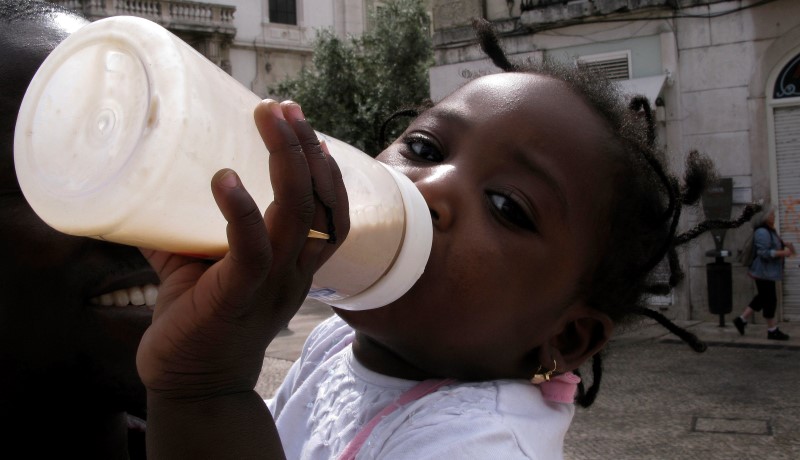By Lisa Rapaport
(Reuters Health) – Babies who drink from large bottles early in life may be experience more weight gain by six months of age than infants who drink from smaller bottles, a study suggests.
Starting when the babies were two months old, researchers tracked their weight based on the size of their bottles, which ranged from 2 ounces to 10 ounces. About 45 percent were being fed from bottles that held at least six ounces of baby formula.
Compared with babies fed from smaller bottles, infants with at least six-ounce bottles had about a half-pound (0.21 kilograms) more weight gain by six months, the study found.
“Every baby is different, but we know that a two-month-old infant will generally take four ounces per feed,” said lead study author Dr. Charles Wood, a pediatrics researcher at the University of North Carolina at Chapel Hill.
“Larger bottles may mean parents are more likely to overfeed their infants, contributing to more weight gain,” Wood added by email.
To assess how bottle size influences infant weight gain, Wood and colleagues focused on 386 babies whose parents fed them only formula.
About 41 percent were black, 35 percent were Hispanic, and 23 percent were white.
Almost two-thirds were from households earning less than $20,000 a year, with parents with no more than a high school education.
Only 298 infants had complete information on weight and length at their six-month checkup, and these infants were included in the analysis.
On average, babies weighed about 7.1 pounds (3.2 kg) at birth, 11.7 pounds (5.3 kg) at two months, and 17.6 pounds (8 kg) at six months, researchers report in the journal Pediatrics.
But babies who used smaller bottles weighed less at two and at six months, 11.2 pounds (5.1 kg) and 17.2 pounds (7.8 kg), respectively.
That compares 11.9 pounds (5.4 kg) at two months and 18.1 pounds (8.2 kg) at six months for infants who had larger bottles.
One limitation of the study is that researchers didn’t directly measure how much babies drank, the authors note.
They also didn’t look at how bottle size changed over time or the range of bottle sizes parents used during the study period. It’s possible that families used different sizes of bottles or used smaller bottles but gave babies multiple bottles at each feeding, the authors point out.
One challenge for bottle-fed babies is that they may have a harder time than breast-fed infants learning to sense when they’re full, said Karen Bonuck, a pediatrics researcher at Albert Einstein College of Medicine and Montefiore Medical Center in New York who wasn’t involved in the study.
With bottle feeding, parents may take a “clean your plate approach because they can visualize any remaining milk in a bottle in a way that they cannot when an infant is being fed at the breast,” Bonuck said by email.
“Parents who purchase larger bottles may be doing so out of a desire to express nurturance through feeding,” Bonuck added.
The problem with this parental impulse is that those first few months are a crucial time for babies to figure out when they’re full, said Dr. Wendy Sue Swanson, a pediatrician at Seattle Children’s Hospital who wasn’t involved in the study.
“It’s known that rapid weight gain is a risk for obesity and it’s also thought that the first few months of life help develop our satiety responsiveness – how our cravings and sense of fullness while eating feel – and therefore if fed excess amounts during that time we may set children up for a bigger challenge with overweight later in life,” Swanson said by email.
SOURCE: http://bit.ly/1TTzRwa Pediatrics, online June 7, 2016.


